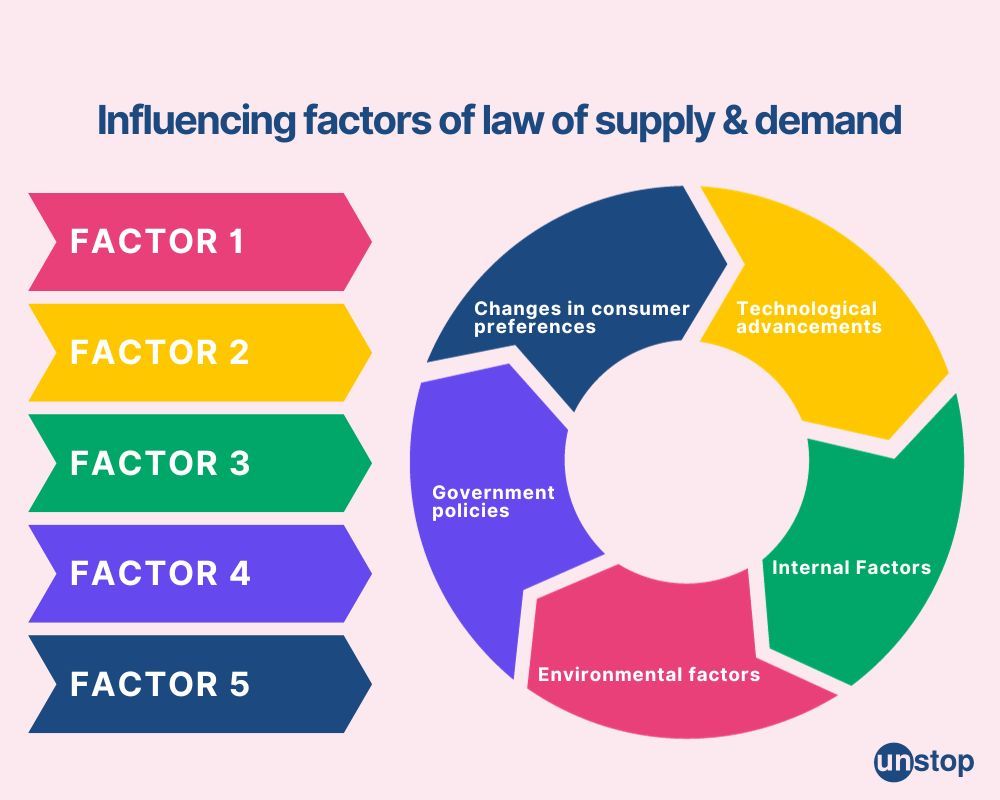- Principles Of Law Of Supply & Demand
- Impacts Of Law Of Supply & Demand
- Factors Affecting Law Of Supply & Demand
- Price Movements In Supply & Demand
- Real-World Examples Of Law Supply & Demand
- Applications Of Law Of Supply & Demand
- Frequently Asked Questions (FAQs)
Law Of Supply And Demand: Principle, Factor & Example Explained

Understanding the law of supply and demand is essential for comprehending pricing mechanisms, market power dynamics, availability of goods, production decisions, and overall economic stability. It serves as a vital balancing mechanism, ensuring the interests of both buyers and sellers are accounted for. The concept revolves around the interaction between consumer demand and market supply.
Principles Of Law Of Supply & Demand
The law of supply and demand is a fundamental concept in economics that helps explain how prices are determined in a market. In essence, it dictates that as prices rise, the quantity supplied by producers increases, while consumer demand decreases. Conversely, when prices decrease, consumer demand rises while producers reduce their supply.
Basic Laws Of Supply & Demand
One of the basic principles of the law is that there is an inverse relationship between price and quantity demanded. When prices are high, consumers tend to buy less because they find it more expensive. On the other hand, when prices are low, consumers are more willing to buy larger quantities since it becomes more affordable.
Another principle is that there is a direct relationship between price and quantity supplied. When prices rise, producers have an incentive to increase production to take advantage of higher profits. As a result, they supply more goods or services to meet the increased demand.
Equilibrium Point In Law Of Supply & Demand
Equilibrium point is an essential concept in understanding supply and demand. It refers to the point at which supply equals demand in a market. At this equilibrium point, buyers can purchase all they want at a given price while sellers can sell all they have at that same price.
When there is excess demand (more buyers than available goods), it leads to shortages and upward pressure on prices. In contrast, when there is excess supply (more goods than willing buyers), it results in surpluses and downward pressure on prices.
Impacts Of Law Of Supply & Demand
The law of supply and demand has significant implications for various aspects of our daily lives.

Pricing & Market Efficiency
Businesses use this law to determine optimal pricing strategies for their products or services. By analyzing market conditions and understanding consumer behavior, companies can adjust their pricing accordingly.
The law helps ensure that markets function efficiently by allocating resources based on consumer preferences. When supply meets demand at equilibrium, resources are allocated efficiently, leading to overall economic welfare.
Government Regulations
Governments often intervene in markets to regulate prices or quantities to protect consumers or ensure fair competition. Understanding the principles of supply and demand helps policymakers make informed decisions when implementing regulations.
Investment Decisions
Investors use supply and demand analysis to identify potential investment opportunities. By studying market trends and predicting future changes in supply and demand, investors can make informed decisions about where to allocate their resources.
Factors Affecting Law Of Supply & Demand
Consumer preferences, technological advancements, and government policies are among the key factors that influence the law of supply and demand. Let's take a closer look at each of these factors.

Changes In Consumer Preferences
When consumers' tastes and preferences change, it directly affects the demand for products. For example, if there is a sudden shift towards healthier food options, the demand for organic produce may increase while the demand for processed foods might decrease. This change in consumer behavior can have a significant impact on suppliers and producers who need to adapt to meet the evolving demands of their target market.
Technological Advancements
Technological advancements play a vital role in shaping supply efficiency. When new technologies are introduced into production processes, it often leads to increased productivity and reduced costs. For instance, automated machinery can streamline manufacturing processes, enabling suppliers to produce goods faster and more efficiently. This increased efficiency can potentially lead to an abundance of supply, which may result in lower prices for consumers.
Government Policies
Government policies such as taxes or subsidies can have a considerable impact on both supply and demand dynamics. Taxes imposed on certain products can increase their prices, thereby reducing consumer demand. On the other hand, subsidies provided by governments can incentivize producers to increase supply by lowering production costs or offering financial assistance. These policies influence market conditions by altering pricing structures and consumption patterns.
Environmental Factors
It is important to note that environmental factors also come into play when considering supply chain problems. Natural disasters or disruptions in transportation networks can hinder suppliers' ability to deliver goods efficiently, leading to potential shortages or delays in meeting consumer demands.
Internal Factors
In addition to these external factors affecting supply and demand, there are also internal variables within industries that influence production costs. Fluctuations in raw material prices or changes in labor costs can impact suppliers' ability to maintain stable pricing structures.
Price Movements In Supply & Demand
Price movements in supply and demand refer to the changes in prices that occur as a result of shifts in the balance between the quantity of goods or services supplied and the quantity demanded. These price movements are influenced by various factors such as changes in consumer preferences, production costs, and market competition.
When Demand Exceeds Supply, Prices Tend To Rise
When there is more demand for a product or service than there is supply available, prices have a tendency to increase. This occurs because consumers are willing to pay higher prices to obtain the limited quantity of goods or services they desire.
For example, let's say there is a sudden surge in the popularity of a new video game console. People are excited about its features and want to get their hands on one as soon as possible. However, due to production constraints or limited availability, the supply of consoles falls short of meeting the high demand. As a result, retailers may increase the price of the console to capitalize on this situation and maximize their profits.
If Supply Surpasses Demand, Prices Typically Decrease
On the flip side, when there is an oversupply of goods or services compared to consumer demand, prices tend to decrease. In this scenario, businesses have excess inventory that they need to sell off quickly before it becomes obsolete or loses value. To entice buyers and move their products off the shelves faster, sellers often reduce prices.
Let's consider an example where farmers experience an abundant harvest season resulting in an abundance of fruits and vegetables flooding the market. With so much produce available but not enough buyers interested in purchasing them all at regular prices, farmers might lower their prices significantly to encourage sales and prevent spoilage.
Shifts In Either Curve Can Lead To Changes In Equilibrium Price
It's important to note that changes in both supply and demand can cause shifts in their respective curves on a graph representing price determination. These shifts can then impact what economists refer to as equilibrium price, which is essentially where supply meets demand at a mutually agreed-upon market price.
For instance, if there is an unexpected increase in consumer income, it can lead to a rise in demand for luxury goods. This shift in the demand curve may result in an increase in the equilibrium price of these products. On the other hand, technological advancements that improve production efficiency might cause a significant increase in supply. As a consequence, the equilibrium price of certain goods or services could decrease due to the surplus available.
Real-World Examples Of Law Supply & Demand
In the real world, the principles of supply and demand play an essential role in determining prices and quantities of goods and services. Here are some examples that illustrate how this economic concept works in practice.
Increased Demand For Medical Supplies During A Pandemic
During a pandemic, such as the recent COVID-19 outbreak, we can witness the law of supply and demand in action. As people become more concerned about their health and safety, there is an increased demand for medical supplies like vaccines, face masks, hand sanitizers, and gloves. This sudden surge in demand puts pressure on the supply chain, resulting in shortages.

Image credit: Freepik
The scarcity of these essential items leads to a change in their prices. In this scenario, we see that the price of medical supplies tends to skyrocket due to high demand and limited availability. People are willing to pay more for these goods because they need them urgently. It's a classic case where the law of supply and demand drives up prices.
Surplus Agricultural Production & Lower Prices
In contrast to situations with high demand, let's consider times when there is surplus agricultural production. When farmers have an abundance of crops or livestock, they may find it challenging to sell all their goods at regular prices due to oversupply. To avoid spoilage or waste, farmers often choose to lower their prices.
By lowering the prices of agricultural products like fruits, vegetables, or dairy products, farmers can attract more customers who are looking for affordable options. The increase in demand resulting from lower prices helps them sell off excess inventory before it goes bad. This strategy allows farmers to recover some costs while preventing losses due to spoilage or waste.
Limited Availability Driving Up Prices For Luxury Items
Luxury items such as designer clothing, high-end electronics, or luxury cars often follow a different pattern. These goods are typically produced in limited quantities compared to mass-market products. As a result, they become highly desirable among consumers seeking exclusivity or status symbols.

Image credit: Freepik
The limited availability of luxury items creates a sense of urgency among buyers who want to own something unique or rare. This high demand, coupled with limited supply, drives up the prices significantly. Manufacturers and retailers can capitalize on this phenomenon by charging premium prices for luxury goods, knowing that there are customers willing to pay a premium for them.
Applications Of Law Of Supply & Demand
Listed below are three key applications and importance of the law of supply and demand:
Helps Businesses Make Informed Pricing Decisions Based On Market Conditions
Businesses constantly face the challenge of determining the right price for their products or services. The law of supply and demand provides valuable insights into market conditions, allowing businesses to make informed pricing decisions. By understanding the relationship between supply and demand, companies can gauge how much consumers are willing to pay for their offerings. For example, if there is high demand for a particular product but limited supply, businesses can increase prices to maximize profits. Conversely, if there is low demand or excess supply, lowering prices may attract more customers and stimulate sales.
Guides Policymakers In Formulating Effective Economic Strategies
Policymakers at both national and international levels rely on the law of supply and demand to develop effective economic strategies. By analyzing market trends and understanding consumer behavior, policymakers can make informed decisions regarding taxation policies, subsidies, trade regulations, and other measures that impact the economy. For instance, during times of inflation when prices are rising rapidly due to increased demand or decreased supply, policymakers may implement measures such as tightening monetary policy or increasing interest rates to curb inflationary pressures. On the other hand, during periods of recession when demand is low and unemployment is high, policymakers may employ expansionary fiscal policies like tax cuts or increased government spending to stimulate economic growth.
Enables Consumers To Understand Why Certain Products Are Priced Differently
Understanding the law of supply and demand empowers consumers by providing them with insights into why certain products are priced differently. When consumers grasp this concept, they can make more informed purchasing decisions based on their preferences and budget constraints. For example, if a product experiences high demand but limited availability (such as limited edition sneakers), its price may be higher due to the scarcity factor. Conversely, if a product has low demand and abundant supply (such as generic store-brand items), its price may be lower.
Conclusion
In this article, we have delved into the definition and principles of the law of supply and demand. We explored the various factors that affect supply and demand, as well as how they interact to determine price movements in different markets. Real-world examples were provided to illustrate the practical application of this law in different industries. By grasping these fundamental concepts, one can make more informed decisions in businesses, investment opportunities, and personal financial planning.
Frequently Asked Questions (FAQs)
1. What are some common factors that affect supply?
Supply is influenced by various factors such as production costs, availability of resources, technological advancements, government regulations or policies, weather conditions (in agriculture), and changes in input prices. These factors can cause shifts in the supply curve either positively (increasing supply) or negatively (decreasing supply).
2. How does demand change with price fluctuations?
Demand tends to be inversely related to price fluctuations; when prices increase, demand typically decreases, and vice versa. However, this relationship may vary depending on whether a good is considered a necessity or a luxury item. Other factors like consumer income levels, tastes and preferences, population changes, advertising campaigns, or promotions can also impact demand.
3. Can you provide an example of how supply and demand interact?
Certainly! Let's consider the market for smartphones. When Apple releases a new iPhone model with advanced features at a higher price point than previous models (increase in price), some consumers might choose not to purchase it due to its high cost (decrease in demand). As a result, if Apple produces too many units anticipating high sales (increase in supply), they may face excess inventory and have to lower the price to stimulate demand.
4. How does the law of supply and demand affect prices?
The law of supply and demand states that as demand increases, prices tend to rise, while as supply increases, prices tend to fall. This relationship is driven by market forces seeking equilibrium between buyers and sellers. When demand exceeds supply, scarcity drives up prices, incentivizing suppliers to increase production. Conversely, when supply exceeds demand, competition among sellers leads to lower prices.
5. Are there any limitations or exceptions to the law of supply and demand?
While the law of supply and demand generally holds true in most markets, there can be exceptions or limitations due to factors like government interventions (price controls), monopolies or oligopolies, external shocks (natural disasters), black markets, or irrational consumer behavior. Certain goods with inelastic demands (e.g., life-saving medications) may see price increases even with decreased demand due to their essential nature.
Suggested reads:
Instinctively, I fall for nature, music, humor, reading, writing, listening, traveling, observing, learning, unlearning, friendship, exercise, etc., all these from the cradle to the grave- that's ME! It's my irrefutable belief in the uniqueness of all. I'll vehemently defend your right to be your best while I expect the same from you!
Login to continue reading
And access exclusive content, personalized recommendations, and career-boosting opportunities.
Subscribe
to our newsletter
















Comments
Add comment